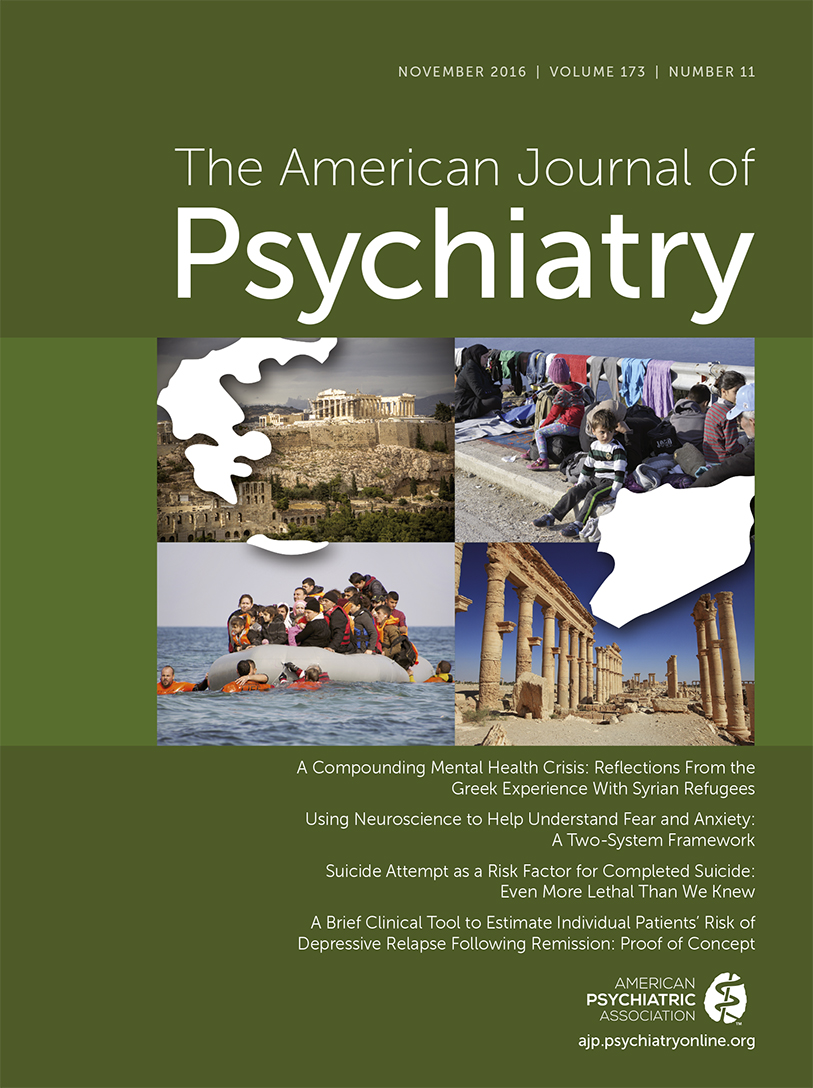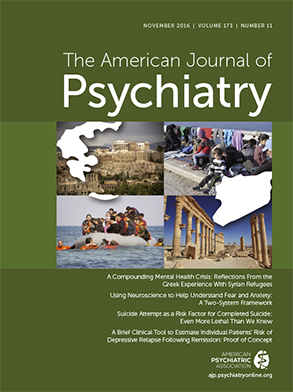This issue of the
Journal brings an interesting study, “Suicide Attempt as a Risk Factor for Completed Suicide: Even More Lethal Than We Knew,” which focuses on the distribution of suicidal acts into nonfatal (suicide attempts) and fatal (suicide deaths) events. Bostwick et al. (
1) report a 5.4% lethality of suicidal acts, implying that slightly more than 5% of persons who carried out a first-ever suicidal act died by suicide either immediately or after a subsequent attempt within a follow-up period ranging from 3 to 25 years. By using this new perspective for assessing the lethality of suicidal acts, an estimate that is an alarming 59% higher than previous figures is obtained (
2–
4). While previous studies were limited to samples of patients from specialized treatment settings, the authors of the present study had access to a population-based sample from a well-defined catchment area. Furthermore, only persons with a first-ever suicide attempt, lethal or not, were included in the study population. Clearly, it makes sense to consider people who died by suicide outside hospital settings as index attempts as well. However, the approach is constrained by the fact that persons in the community who have attempted suicide and survived without attending hospital care are not included in the figure; hence, the risk of suicide after suicide attempt might be slightly overestimated because the nontreated persons surviving suicide attempt will be invisible.
To classify suicide attempts into first-ever and repeat episodes is often linked to some uncertainty, but Bostwick et al. had access to up to 60 years of preindex attempt data on clinical presentations; it is therefore likely to truly be an incident sample. Compared with first-ever suicide attempts, people with a history of more than one suicide attempt have increased risk of subsequent suicide (
5,
6). Among those who survived the index episodes in the present study, approximately 2.2% (N=33/1,442) of the first-ever presentations with a nonfatal suicide attempt died by suicide during the follow-up. This is comparable to figures previously reported by Zahl and Hawton (
6), where 1.9% (95% confidence interval=1.5%−2.3%) of persons with first-ever suicide attempts died by suicide over long-term follow-up. Most follow-up studies have focused on suicide mortality after suicide attempt in general, regardless of whether it was a first-ever or repeat episode (
7–
9). A recent meta-analysis of such studies found that 1.6% of persons who presented with a suicide attempt would have a fatal repeat episode within the subsequent year and 3.9% within 5 years (
10).
The risk of repeating a suicide attempt is highest in the time shortly after the index attempt (
7,
11). As demonstrated convincingly in the study by Bostwick et al., more than 80% of the observed suicide deaths occurred within a year of the index attempt. Although a lifetime follow-up was not applied, other studies (
12) support the notion that intervention should be initiated immediately after an attempt. A variety of different psychosocial interventions for persons after suicide attempt have bloomed, and a wide range of support models have been evaluated. A recently published Cochrane review provides encouraging results, particularly regarding cognitive-behavioral therapy for adults (
13). Additionally, psychosocial therapy provided in outpatient clinics specialized in suicide prevention is linked to reductions in repeat episodes, as well as mortality (
14). Bostwick et al. found that survivors of a first-ever suicide attempt had lower risks of dying by suicide if they had received either psychiatric or medical hospitalization or had been scheduled for psychiatric follow-up appointment upon discharge. Overall, this indicates that immediate psychosocial intervention after a nonfatal suicide attempt is important.
How Early is Too Late?
The study by Bostwick et al. demonstrates that 59% of those who died by suicide did not survive their first-ever attempt. Most suicide preventive interventions focus on high-risk groups, such as survivors of suicide attempt, but a figure as high as 59% underscores the need for universal preventive strategies aimed at the societal level. A large share of persons who carry out a suicide attempt do not receive professional help ahead of the act. Thus, access to supportive counseling should ideally be made available 24/7, for instance, by help lines, crisis outreach teams, online chat services, or self-help tools. Public health initiatives such as raising community awareness of signs or symptoms of people in suicidal crisis are important. Likewise, eliminating barriers for seeking help, such as reducing costs, distance, and stigma, could be important initiatives. Restriction of means is another universal prevention strategy. Here, case-fatality rates, which express the lethality of specific methods, may inform decision makers on how to set priorities. In a study of seven U.S. states, Miller et al. (
15) found a case-fatality rate of 91% for firearms, 3% for poisoning/cutting/piercing, 80% for suffocation/hanging, and 30% for all other methods. In comparison, Bostwick et al. noted a 61% case-fatality rate when firearms were used in a first-ever suicidal act. Both studies underscore the high lethality of guns, suggesting that availability ought to be restricted. Implementation of legal restrictions regarding permission to purchase firearms, waiting periods, safe storage, background checks, and registration guidelines have been linked to decreases in rates of firearm suicides, although mixed results have been shown, especially with regard to the effect on the overall suicide rates (
16,
17)
A suicidal act is the result of a temporary state of the mind. Once initiated, it is of uttermost importance to win time in order to allow the condition to improve by itself or through treatment. A low case-fatality rate indicates that there is a low probability that the suicidal act will end as a fatal event; in other words, chances that the person will get help are good. Most often, firearms do not allow for a change of mind or medical attention to arrive in time. It is, thus, alarming that 21,175 (51%) persons who died by suicide in the United States in 2013 used firearms (
http://www.cdc.gov/nchs/fastats/suicide.htm). In the present study, nearly 75% of first-ever fatal attempts among men were by firearm. Not only do many men lose their life to suicide by firearms, they do so without having received any kind of support or medical attention. The Office of the Surgeon General and National Action Alliance for Suicide Prevention emphasizes that the restriction of access to firearms is one of the main pathways to reducing the losses caused by suicides in the United States (
6,
18).
Most people who attempt suicide have a long life ahead of them; ultimately, nine out of 10 will die by other causes of death. Most people who attempt suicide change their mind. However, if a suicidal act is carried out with a firearm, a second chance is seldom given.

